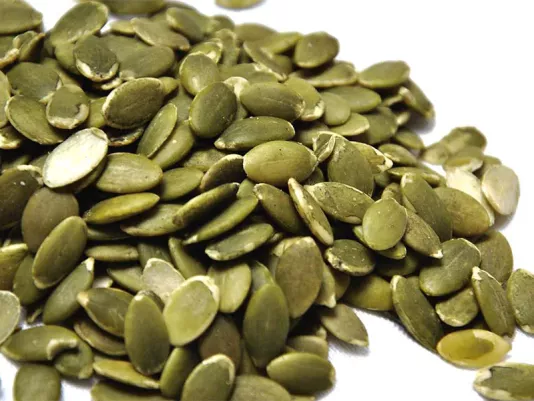Pumpkin Gingerbread Men
Pumpkin gingerbread men – Christmas baked goods are always colorful and interesting, filled with bright aromas.

Pumpkin Seeds are an ingredient that holds a special place in my kitchen. I’ve learned to handle them carefully, since even a small mistake in roasting can ruin both taste and aroma. The seeds have a delicate balance between richness and a light malty note that develops beautifully with gentle heat. I’ve often found that fresh, not overdried seeds can give salads or cookies depth without excessive oiliness. They hold their shape well, don’t crumble after roasting, and keep their aroma for a long time if stored in a dry, airtight container. In my experience, this is one of those ingredients that pairs easily with both sweet and savory flavors, as long as you maintain balance and proper temperature.
I always recognize good seeds by touch: they are firm, not overdried, and have no foreign smell. When I take a handful and squeeze, there should be no powder or greasy residue – a sign of improper storage. Over the years, I’ve learned that color says a lot too: light green kernels indicate freshness, while dull gray ones signal aging or excess moisture. I always check that the seeds aren’t cracked and have no rancid taste, which appears when exposed to air. I only buy from trusted places where the product is kept dry, since humidity quickly spoils the flavor. If I buy peeled seeds, I immediately transfer them to a glass jar with a tight lid. From experience, proper storage preserves their fragrant freshness three times longer than factory packaging. The seed variety also matters: large kernels have more flesh, while smaller ones have a stronger nutty flavor. I choose the former for baking and the latter for salads. The key is not to chase shine, because polishing removes the natural protective layer and shortens shelf life.
Before adding pumpkin seeds to a dish, I always rinse them in cold water and dry them on a towel. Even store-bought peeled seeds can contain traces of dust or oil from processing. Then I lightly toast them in a dry skillet over low heat to revive the aroma. If I need a crisp texture, I roast them longer but never let them turn dark brown – that’s when they become bitter. For desserts, I add a pinch of salt: it highlights sweetness and stabilizes flavor during baking. In my experience, mistakes often happen out of haste – too much heat makes the seeds hard outside and raw inside. So I always let them “breathe”: I spread them in a thin layer and stir occasionally. For sauces, I grind them only after they’ve completely cooled, because warm seeds release excess oil and form a thick paste. Whatever remains, I store in a jar with rice at the bottom – it absorbs moisture and keeps the seeds from clumping.
When I work with pumpkin seeds, I always rely on sound and smell. In the pan, they start crackling after about three minutes on medium heat – that’s when it’s time to stir. At around 150°C (300°F), they toast evenly while keeping their inner softness. If the temperature is higher, the oil inside overheats, producing a smoky smell instead of a delicate nutty aroma. Over time, I’ve learned not to rely solely on a timer – the best indicators of doneness are even color and a subtle sheen. When making a batch for salads, I remove them a bit earlier, as they continue cooking from residual heat. For baking, on the other hand, I roast them to a deeper hue so they can withstand contact with moist dough. I never add extra oil – pumpkin seeds have their own natural one. When roasting in the oven, I spread them in a thin layer and stir once or twice, otherwise they cook unevenly. I always trust my senses: the aroma tells me more than any thermometer.
Pumpkin seeds have a warm, nutty flavor with a gentle malty note that I often use for contrast in dishes. Combined with lemon juice or mild acidic dressings, they reveal a light creaminess you wouldn’t expect from a plant-based product. In sweet recipes, they work beautifully with honey, cinnamon, vanilla, or caramel – these enhance their natural softness. I often add them to vegetable purées for balanced texture, or to cream soups for pleasant density. In salads, pumpkin seeds replace nuts when I want a lighter option without an intense aroma. The key is not to overload the dish: two tablespoons per serving are usually enough. From experience, I know they “get along” with greens, grains, soft cheeses, and white sauces. When paired with meat or poultry, it’s best to roast them until crisp – that way, their aroma stands out. All of this provides a wide space for creativity without the need for complex techniques.
Most problems arise from neglecting small details. Overdried seeds become brittle and lose aroma, while raw ones are hard to digest. I always recommend paying attention to their smell after storage: if there’s even a hint of bitterness, it’s best not to risk it. During roasting, never leave the pan unattended – a few seconds can ruin the whole batch. Another common mistake is storing them in an open container near the stove: steam and heat accelerate oxidation. In my practice, even high-quality seeds spoiled within a week that way. It’s also unwise to grind them in advance: air exposure quickly changes the flavor. To check quality, I bite a seed in half – if the core is even, with no dark spots, the seed is fresh. If it has a sharp taste, it’s better used in savory dishes or discarded immediately. Pumpkin seeds are unpretentious, but they demand respect for detail – and that’s what makes even simple dishes with them look professional.